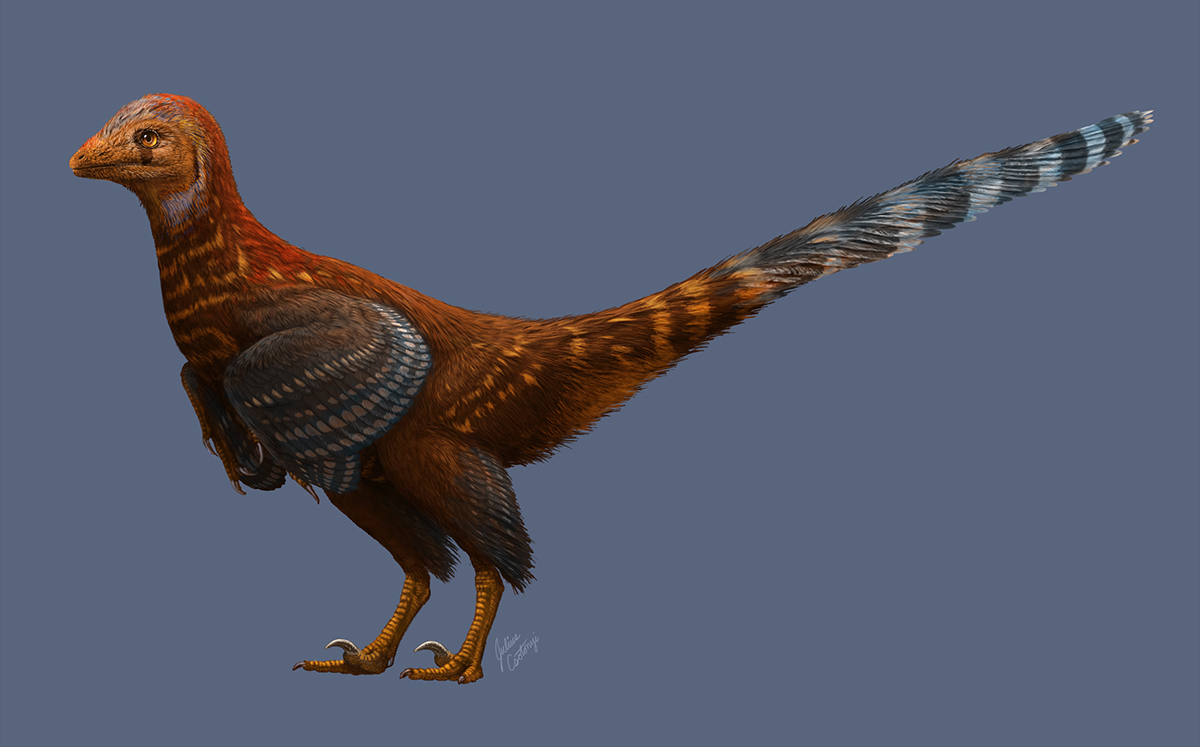
Life reconstruction of the asymmetrically feathered troodontid Jianianhualong tengi by Julius Csotonyi
A new species of feathered dinosaur from China is answering questions and raising many more as paleontologists continue the quest to reconstruct the early evolution of feathered dinosaurs. The earliest reported troodontid, or bird-like dinosaur, Jianianhualong tengi has the distinct feature of asymmetric feathers, typically associated with aerodynamics. However, scientists say there is no evidence to suggest the animals ever flew.
"As the closest relatives to birds, troodontids are certainly one of the most interesting groups of dinosaurs, and any time you find a feathered dinosaur and discover a new species is pretty cool," says Professor Philip Currie, Canada Research Chair in Dinosaur Paleobiology at the University of Alberta.
"Every time you find a missing link between two animals, you create two new missing links." -Philip Currie
Jianianhualong lived during the Early Cretaceous, roughly 125 million years ago, in what is now Northeastern China. This ancient ecosystem in the Liaoning Province is famous for its feathered dinosaurs. Large feathers would have adorned the forelimbs, hind limbs, and tail. Currie explains that Jianianhualong tengi demonstrates mosaic evolution-the process where parts of the animal's skeletons changed without simultaneously affecting other portions-something becoming increasingly common as dinosaur discoveries continue to develop. "With mosaic features, we're looking for the answer as to why there's a combination of primitive and advanced features."
These new findings help researchers to better understand how both these animals and their avian cousins evolved but leave a mystery as to why the animals would have had asymmetric feathers if they weren't used for flight.
Feathered but flightless
"Every time you find a missing link between two animals, you create two new missing links," continues Currie. "The only way to answer these questions is to find more animals to fill in the gaps. But that's the beauty of cladistics, where we categorize common ancestors. You're making the assumption you haven't found the direct link, so you infer by comparison. The reality is you never get all of the characteristics, but we keep searching."
Currie estimates that only one per cent of one percent of all of the world's dinosaurs has been identified to date, and discoveries like this indicate that the hunt to understand the evolution of these prehistoric creatures is in no danger of slowing down. Though he himself has been involved with naming more than two dozen new dinosaurs over the course of his career-with another two new specimens set to be published in the near future-Currie describes the discovery process as something that never gets old. "For me, rather than naming the dinosaurs, it's describing them for the first time that's really exciting."
Dinosaur-bird family tree
One of the world's preeminent paleontologists, Currie is well known for his early work on making the connection between dinosaurs and birds. Though the claim had been made in the mid-1800s, Currie was one of the first to publish results on the connection in the 1980s, around the time that he was involved in the Canada-China Dinosaur Project. This initiative not only helped solidify the interconnectedness between these pre-historic animals in the two countries but also paved the way for three decades of ongoing research collaboration.
For this most recent discovery, Currie worked with an international team of paleontologists on the recent finding, including Michael Pittman from the University of Hong Kong and Xing Xu from the Institute of Vertebrate Paleontology and Paleoanthropology (Chinese Academy of Sciences).
"Mosaic evolution in an asymmetrically feathered troodontid (Dinosauria: Theropoda) with transitional features" was published May 2 in the open-access journal Nature Communications.